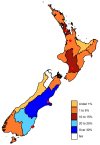Isolates, Antimicrobial Susceptibility Profiles and Multidrug Resistance of Bacteria Cultured from Pig Submissions in New Zealand
- PMID: 32824043
- PMCID: PMC7460312
- DOI: 10.3390/ani10081427
Isolates, Antimicrobial Susceptibility Profiles and Multidrug Resistance of Bacteria Cultured from Pig Submissions in New Zealand
Abstract
Data on the scope of bacterial pathogens present and the frequency of antimicrobial resistance (AMR) in New Zealand's pigs are limited. This study describes bacterial isolates, antimicrobial susceptibility data, and multidrug resistance (MDR; resistance to ≥3 antimicrobial classes) from New Zealand pig submissions. Porcine test data from June 2003 to February 2016 were obtained from commercial veterinary pathology laboratory records. In total, 470/477 unique submissions resulted in bacterial growth, yielding 779 isolates. Sample type was recorded for 360/477 (75.5%); lung (79/360; 21.9%), faecal (61/360; 16.9%) and intestinal (45/360; 12.5%) were most common. The most common isolates were Escherichia coli (186/779, 23.9%), Actinobacillus pleuropneumoniae (43/779; 5.5%), Streptococcus suis (43/779; 5.5%), unidentified Campylobacter spp. (38/779; 4.9%), alpha haemolytic Streptococci (32/779; 4.1%), coagulase negative Staphylococcus spp. (26/779; 3.3%), and Pasteurella multocida (25/779; 3.2%). Susceptibility results were available for 141/779 (18.1%) isolates from 62/470 (13.2%) submissions. Most were susceptible to trimethoprim-sulphonamide (75/81; 92.6%), but fewer were susceptible to penicillin (37/77; 48.1%), tilmicosin (18/43; 41.9%), or tetracyclines (41/114; 36.0%). No susceptibility data were available for Salmonella spp., Campylobacter spp., or Yersinia spp. isolates. MDR was present in 60/141 (42.6%) isolates. More data on sample submission drivers, antimicrobial drug use, and susceptibilities of important porcine bacterial isolates are required to inform guidelines for prudent antimicrobial use, to reduce their prevalence, human transmission, and to minimise AMR and MDR.
Keywords: antimicrobial; bacteria; multidrug; pig; porcine; pork; resistance; susceptibility.
Conflict of interest statement
The authors declare no conflict of interest.
Figures

Similar articles
-
Isolates, antimicrobial susceptibility profiles and multidrug resistance of bacteria cultured from samples collected from sheep in New Zealand (2003-2016).N Z Vet J. 2021 Jan;69(1):20-26. doi: 10.1080/00480169.2020.1789517. Epub 2020 Aug 11. N Z Vet J. 2021. PMID: 32623972
-
Bacterial isolates, antimicrobial susceptibility and multidrug resistance in cultures from samples collected from beef and pre-production dairy cattle in New Zealand (2003-2016).N Z Vet J. 2019 Jul;67(4):180-187. doi: 10.1080/00480169.2019.1605943. Epub 2019 May 6. N Z Vet J. 2019. PMID: 30971180
-
Antimicrobial susceptibility of bacteria isolated from neonatal foal samples submitted to a New Zealand veterinary pathology laboratory (2004 to 2013).N Z Vet J. 2016 Mar;64(2):107-11. doi: 10.1080/00480169.2015.1109006. Epub 2015 Nov 23. N Z Vet J. 2016. PMID: 26496417
-
Amoxicillin-current use in swine medicine.J Vet Pharmacol Ther. 2018 Jun;41(3):356-368. doi: 10.1111/jvp.12482. Epub 2018 Jan 19. J Vet Pharmacol Ther. 2018. PMID: 29352469 Review.
-
Meta-Analysis of the Prevalence of Porcine Zoonotic Bacterial Pathogens in India: A 13-Year (2010-2023) Study.Pathogens. 2023 Oct 21;12(10):1266. doi: 10.3390/pathogens12101266. Pathogens. 2023. PMID: 37887783 Free PMC article. Review.
Cited by
-
How Streptococcus suis escapes antibiotic treatments.Vet Res. 2022 Nov 12;53(1):91. doi: 10.1186/s13567-022-01111-3. Vet Res. 2022. PMID: 36371221 Free PMC article. Review.
-
Resistance of Streptococcus suis Isolates from the Czech Republic during 2018-2022.Antibiotics (Basel). 2022 Sep 7;11(9):1214. doi: 10.3390/antibiotics11091214. Antibiotics (Basel). 2022. PMID: 36139993 Free PMC article.
-
Reducing the Risk of Transmission of Critical Antimicrobial Resistance Determinants From Contaminated Pork Products to Humans in South-East Asia.Front Microbiol. 2021 Jul 27;12:689015. doi: 10.3389/fmicb.2021.689015. eCollection 2021. Front Microbiol. 2021. PMID: 34385984 Free PMC article. Review.
-
TroR Negatively Regulates the TroABCD System and Is Required for Resistance to Metal Toxicity and Virulence in Streptococcus suis.Appl Environ Microbiol. 2021 Sep 28;87(20):e0137521. doi: 10.1128/AEM.01375-21. Epub 2021 Aug 11. Appl Environ Microbiol. 2021. PMID: 34378993 Free PMC article.
-
A novel bicyclic 2,4-diaminopyrimidine inhibitor of Streptococcus suis dihydrofolate reductase.PeerJ. 2021 Feb 3;9:e10743. doi: 10.7717/peerj.10743. eCollection 2021. PeerJ. 2021. PMID: 33604179 Free PMC article.
References
-
- Heffernan H., Wong T.L., Lindsay J., Bowen B., Woodhouse R. A Baseline Survey of Antimicrobial Resistance in Bacteria from Selected New Zealand Foods. Ministry of Agriculture and Forestry; Christchurch, New Zealand: 2011.
LinkOut - more resources
Full Text Sources
Miscellaneous

